Baoquocte.vn. Four sacred temples: Bach Ma, Voi Phuc, Kim Lien, and Quan Thanh were built with the purpose of warding off evil spirits and protecting the ancient Thang Long capital.
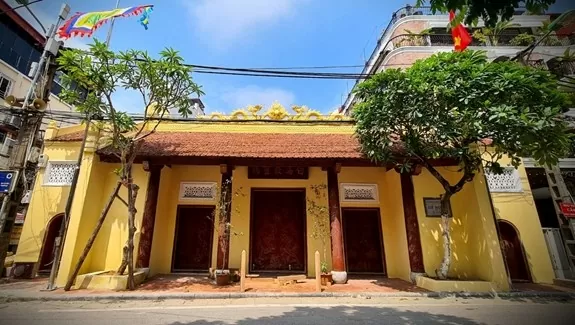 |
| Located in the heart of Hanoi's Old Quarter, Bach Ma Temple is one of the Four Guardian Temples of Thang Long, guarding the eastern side of the Thang Long citadel. (Photo: Thuy Linh) |
Bach Ma Temple
Bach Ma Temple is one of the famous historical landmarks in Hanoi. Located in Tho Xuong district, Hoai Duc prefecture, it is now situated at 76 Hang Buom Street, Hoan Kiem District, Hanoi. The temple is known as the "Eastern Guardian of Thang Long Citadel".
The Bach Ma Temple is dedicated to the god Long Do (also known as the god of Long Do mountain), along with Nung mountain - the place that receives the sacred energy of Thang Long capital. There are many historical stories related to the temple. Among them, the most well-known is the story of King Ly Thai To.
Legend has it that when King Ly Thai To moved the capital to Dai La and renamed it Thang Long, he ordered the construction of a rampart, but the rampart kept collapsing as soon as it was built. The king then sent people to pray here, and as soon as they finished praying, they saw a white horse emerge from the temple, circling from east to west, leaving footprints wherever it went.
Seeing this, the king ordered the construction of a city wall following the horse's footprints, and indeed, the wall was completed and stood firm. From then on, the king had the temple renovated and bestowed the title of "National Capital City Guardian Deity Great King" upon Long Đỗ, and named the temple "Bạch Mã Linh Từ" (White Horse Sacred Temple).
The temple complex includes the following structures: the triple gate, the main hall, the pavilion, the incense burning area, the inner sanctuary, and the council house. The triple gate is divided into five sections. The pavilion is built in a two-story, eight-roofed, curved architectural style.
Connecting the pavilion and the main hall is a dome shaped like a crab's shell. The wooden columns are richly decorated, showcasing the skillful and exquisite craftsmanship of the artisans.
The incense hall and the inner sanctuary of the temple have quite similar architecture, with a two-tiered roof featuring curved eaves. The statue of the White Horse deity is placed inside the inner sanctuary.
Currently, the temple still preserves 15 ancient stone steles and many valuable ancient artifacts such as the horizontal plaque "Dong Tran Linh Tu", "Co Long Ngai", and religious objects including ancient weapons such as swords, sickles, chains, etc., all exquisitely carved.
Notably, this sacred temple within the Four Guardian Temples of Thang Long still preserves a geomantic energy point. This is a well located to the right of the temple, which is important according to the concept of left-yang and right-yin, and the geomantic well represents yin.
With its rich history and unique architecture, Bach Ma Temple was classified as a historical and cultural relic in 1986.
Elephant Temple
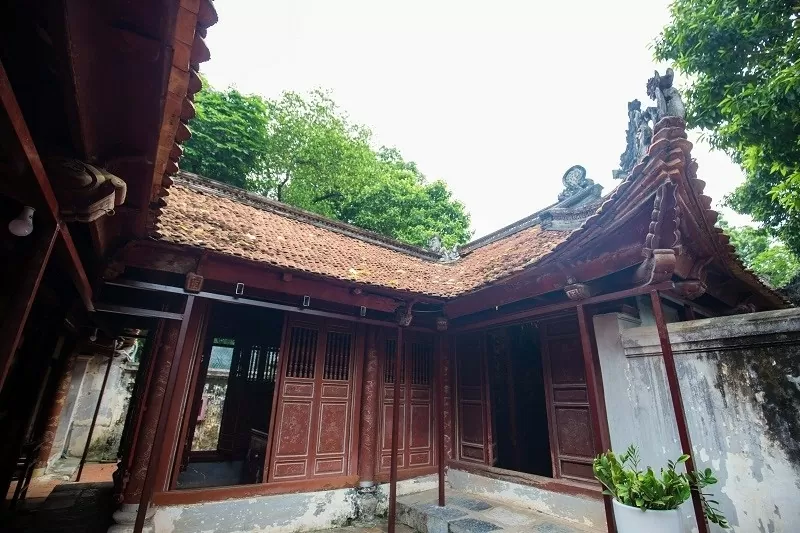 |
| The incense burning hall has wooden doors that open on all four sides, and inside are the dragon throne and ancestral tablets of the gods. The rear hall consists of three sections, with altars featuring several wooden and bronze statues. (Photo: Duy Khánh) |
The Voi Phuc Temple is a special national monument known as one of the Four Guardian Temples of Thang Long. The temple was established during the reign of King Ly Thai Tong (1028-1054) in the southwestern corner of the old Thang Long citadel, in the area of Thu Le village, now Thu Le Park.
The temple is dedicated to the deity Linh Lang, who assisted King Ly Thanh Tong in the war against foreign invaders, repelling the Song dynasty from our country. After his death on the Cau River front in 1076, the people of Thu Le built a temple in his honor, and the king bestowed upon him the title of Great King Linh Lang, a supreme benevolent deity. Because there are two kneeling elephants in front of the temple, the locals call it the Elephant Kneeling Temple; the name Tay or Doai comes from the temple's location to the west of the capital city.
Upon arriving at this temple, located within the four sacred sites of Thang Long, you will be amazed by its solemn, ancient architecture steeped in history. There are three paths leading to the temple grounds. The central path, with 12 wide stone steps, is used for processions on festive days, while the two side paths are for everyday use.
In front of the courtyard, in the middle of the main pathway, is a semicircular well, built with the meaning of praying for water and wishing for abundance, expressed through a pair of round stone dragons carved from clouds.
Stepping inside, visitors will discover the ancient beauty of the temple roof, intricately carved with phoenixes, unicorns, dragons, pearls, and tigers. Additionally, the main hall houses the ancestral tablets, the throne, and a majestic statue of the deity Linh Lang. The rear hall of the temple is also constructed of ironwood and features a pair of stone mythical creatures in front of the porch.
The Voi Phuc Temple also features many ornate plaques and couplets in Chinese characters, painted in red and gold. The content mainly praises the virtues and sacredness of the deities.
Kim Lien Temple
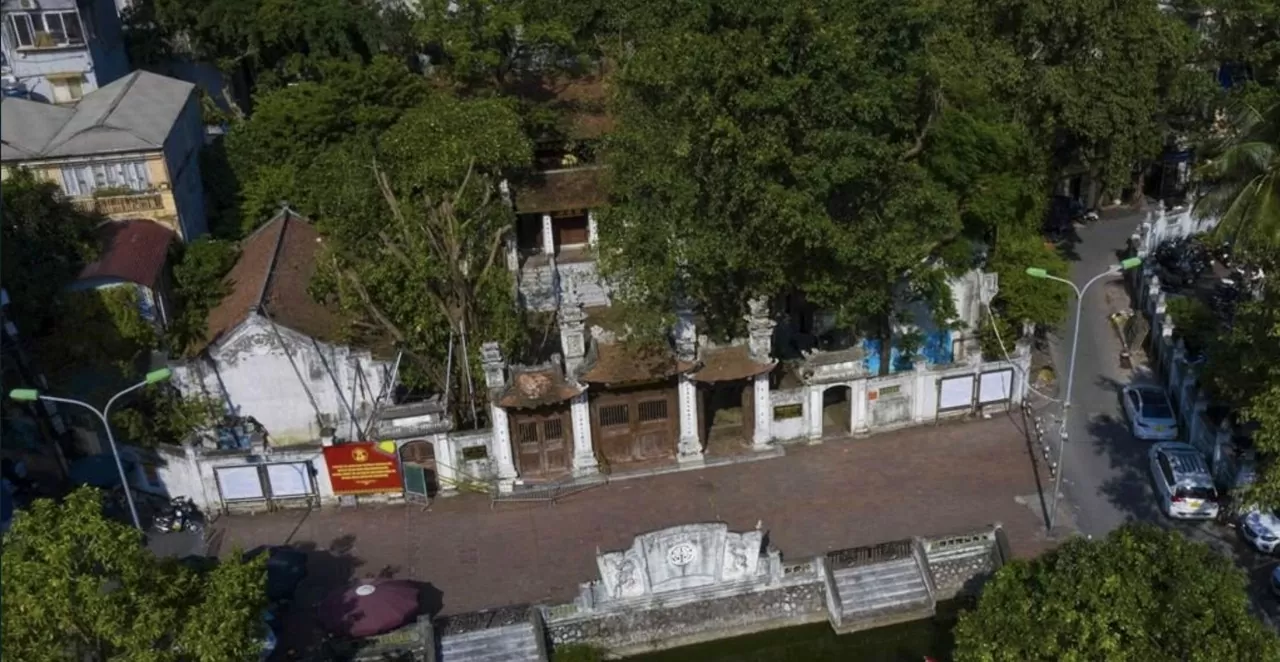 |
| Kim Lien Temple still preserves many valuable artifacts. (Photo: Minh Duc) |
Kim Lien Temple (also known as Kim Lien communal house), located in Phuong Lien ward, Dong Da district, was built in 1509 and is dedicated to Cao Son Dai Vuong. This was the southern outpost of the ancient Thang Long citadel.
According to historical records, Kim Lien Temple was built when King Ly Thai To moved the capital from Hoa Lu to Thang Long to protect the southern part of the new capital. In the past, the Kim Hoa area (also known as Dong Lam in the vernacular) was a swampy, low-lying region. The temple was built on the highest mound in the area and dedicated to the deity Cao Son Dai Vuong, who prayed for divine assistance in farming and for the mitigation of natural disasters for the people.
The temple is built on a high mound east of Kim Lien lagoon. The temple gate and the main entrance of the main hall both face west. The temple's architecture consists of two parts: the front part on the mound has a gate with pillars, two spacious brick courtyards on either side, and the main structure of the monument is located within the grounds.
The main temple complex consists of: the ceremonial gate, the main hall, and the rear sanctuary. The ceremonial gate is a three-bay building. From the outside in, there are gate pillars, the tops of which are topped with overlapping ceramic bricks, with lanterns hanging below. Inside, the four mythical creatures are skillfully and exquisitely carved.
The main architecture of the historical site consists of three gates and a temple dedicated to a deity. After passing the steps, you will ascend nine high brick steps built with large bricks from the Le Trung Hung period, connecting the outdoor structure to the main building. On either side of the steps, near the brick courtyard, are two stone crocodiles dating back to the Le dynasty. Beyond the steps are three entrances to the Cao Son Temple.
The main hall has a very unique T-shaped design. The rear hall is a three-bay building constructed of brick and roofed with tiles. Located in the last bay of the rear hall is the shrine dedicated to Cao Son Dai Vuong and two goddesses of harmony.
Besides its unique architectural features, Kim Lien Temple also preserves many valuable artifacts such as a stele composed by historian Le Tung in 1510; and 39 royal decrees from various emperors to acknowledge and praise the merits of the deity Cao Son…
These are exceptionally valuable artifacts, serving as "chronicles" that fully record the history of the temple's construction, the deity worshipped within it, and provide evidence of the temple's origins.
Given its outstanding historical, cultural, scientific , and aesthetic value, in 2022 the Thang Long Four Guardian Temples - Kim Lien Temple historical and architectural site was classified as a Special National Monument.
Quan Thanh Temple
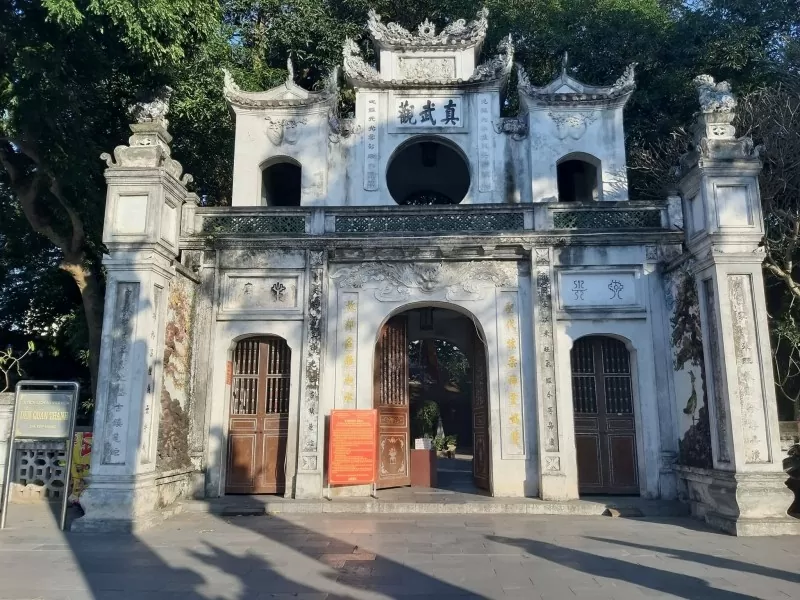 |
| Quan Thanh Temple, built during the Ly Dynasty, has undergone numerous renovations and is one of the few historical sites that still bears traces of Taoism – a religion that was once extremely popular in Vietnam. (Photo: KT) |
Quan Thanh Temple is one of the Four Guardian Temples of Thang Long, alongside Bach Ma Temple, Voi Phuc Temple, and Kim Lien Communal House. This temple is dedicated to Huyen Thien Tran Vu. Initially, the temple was located south of the To Lich River. After the capital was moved to Thang Long, King Ly Cong Uan moved the temple to its current location, hoping that Huyen Thien Tran Vu would help control the water monster of West Lake and protect the northern part of Thang Long citadel.
Quan Thanh Temple is located opposite West Lake, at the intersection of Thanh Nien and Quan Thanh streets in Ba Dinh district, Hanoi. Along with Bach Ma Temple, Kim Lien Temple, Voi Phuc Temple, etc., the temple is a famous spiritual destination in Hanoi, attracting a large number of domestic and international tourists to visit and worship.
According to historical records, Quan Thanh Temple was built in the early years after King Ly Thai To moved the capital from Hoa Lu to Thang Long, on Hoi Long hill northeast of West Lake. Quan Thanh Temple is a unique architectural and artistic work, preserving many valuable documents about architectural art, sculpture, and religious beliefs from various periods of Vietnamese history.
This temple has two names: Tran Vu Quan and Quan Thanh Temple. As one of the Four Guardian Temples of Thang Long, Quan Thanh Temple is dedicated to Huyen Thien Tran Vu. Legend says he was the god who governed the North, helping the people to ward off evil spirits and monsters, eliminating the nine-tailed fox at West Lake and the fox spirit on the Red River during the reign of King Ly Thanh Tong…
The temple's architecture follows the "inner" "dinh," "outer" style. The outermost structure is an impressive four-pillar ceremonial gate featuring phoenixes back-to-back and a mythical creature (Nghê) at the top. Surrounding the four pillars are striking details such as fish transforming into dragons, tigers descending from the mountain, and couplets, all contributing to an atmosphere of majesty and antiquity.
Next is the bell tower where the bell cast in the year Dinh Ty during the reign of Le Hy Tong (1677) is hung. Inside are the main hall and the rear hall. On the left and right sides of the main hall are bronze plaques inscribed with "De Chan Vu Quan," by King Thieu Tri himself.
Furthermore, this structure, located within the Four Guardian Temples of Thang Long, also features many valuable works of art, exquisitely carved on doors, columns, beams, horizontal plaques, and couplets written in Chinese characters. The temple also houses a bronze bell cast during the time of Lord Trinh.
Currently, Quan Thanh Temple has temporarily suspended all visitor activities for renovation, restoration, and repair of various items until December 5th.
Source: https://baoquocte.vn/du-lich-ha-noi-ghe-tham-thang-long-tu-tran-linh-thieng-trong-long-thu-do-295359.html






![[Photo] Closing Ceremony of the 15th Conference of the Central Committee of the 13th Party Congress](/_next/image?url=https%3A%2F%2Fvphoto.vietnam.vn%2Fthumb%2F1200x675%2Fvietnam%2Fresource%2FIMAGE%2F2025%2F12%2F23%2F1766462841764_a1-bnd-3731-1647-jpg.webp&w=3840&q=75)





































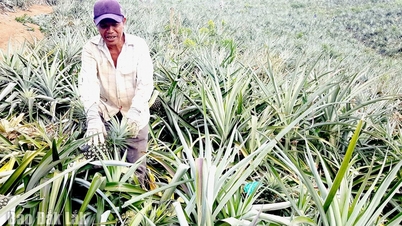
























































Comment (0)